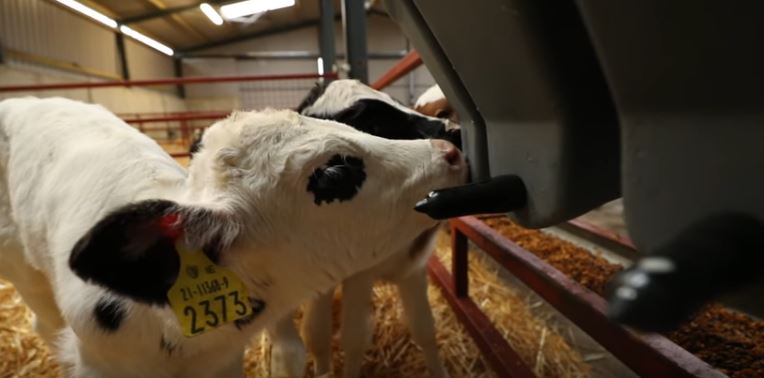Michael O’Carroll farms approximately 300 acres and milks 180 cows in Lisdowney, Co Kilkenny and places a lot of attention on getting calf nutrition right.
Michael’s brother John works on the farm with him full-time and his son Brian is studying Agricultural Science at Waterford Institute of Technology (WIT).
Ray Killeen, also studying agriculture in WIT, is completing his work placement on the farm. The cows on the farm have an average milk yield of 6,100L and 500kg of solids.
Fertility
Michael uses AI on his maiden heifers.
“We started inseminating cows on April 28. The maiden heifers get three weeks of A.I. and then an Angus stock bull is introduced.
“All the maiden heifers calve down at 23-24 months. The milking cows get seven-to-eight weeks of A.I. and similarly and stock bull is introduced thereafter.”
This is to ensure a compact calving interval. The breeding season lasts 12-13 weeks, but Michael would aim to have 75-80% of the herd calved within six weeks.
Michael aims to start calving on Feb 1 and this year he started calving on January 26 and he keeps both beef and dairy breeds on the farm.
“I rear all calves on the farm both bulls and heifers.
“I sell the Friesian bull calves in the earlier part of the season, selling the Angus in the second half of the season. I sell them at 18 months in August off the grass,” he said.
Calf Nutrition
Michael has been working closely with his GAIN Feeds Senior Business Manager, Pat Tennyson on the Feed For Growth calf rearing programme over the past year.
“We have a very strict procedure when it comes to colostrum. Once the calf is born, the cow is milked immediately and the calf is given three litres of colostrum via stomach tube,” he said.
Michael believes that you have to be strict on this to ensure that the calves stand the best chance of survival.
Video: Highlighting the importance of calf nutrition
The O’Carroll’s use GAIN Easi Mix Calf Milk Replacer from three days onwards.
“It’s easy to mix and the 25% protein level promotes good early growth,” Michael stated.
The young calves find the milk replacer easy to digest and the Biomos and Digest VO in the health package gives their immune system a good boost.
“We start the calves on two litres of milk replacer at 125g per litre morning and evening and over the space of 10 days we have them up to three litres of milk replacer at 125 grams per litre morning and evening.”
Michael introduces GAIN Starta Calf ad-lib once the calf enters the pen. It’s important to keep it fresh so the calves eat it.
He removes the calves from the cows straight away. They are then put on GAIN Calf Crunch a week later.
GAIN Feeds Senior Business Manager Pat Tennyson adds that both calf feeds contain Yea-Sacc® live yeast from Alltech which supports digestion and calf performance.
“They are High in Vitamin E and contain Minplex (Bioplex® copper, zinc, manganese & Selplex® selenium) protected minerals which improve mineral availability,” he said.
Weight Targets
With the right feeding and management, Michael aims to have the calves weighing 40-45kg at birth.
“We would aim for a target weight at weaning of about 90kg plus.
“We would plan to have the maiden heifers weighing about 300kg at first service, but this year they have exceeded this target, averaging at 330kg.”
Benefits of Programme
Michael believes that the biggest benefit of the Feed for Growth programme has been the continuous monitoring of the herd’s performance from GAIN Feeds Senior Business Manager, Pat Tennyson.
“It makes a huge difference. We would work very closely with Pat in ensuring that all the calves are meeting their targets.”
Key Learnings
Michael admits that the most important thing is to get colostrum into the calf as it’s critical to avoid scours and sicknesses for the first couple of weeks.
We found that it made a huge difference to the performance of the calves in terms of weight gain. If you can pack it into them in the first two to three months we find that we get a huge response.
“The calf will only drink what he can. Before we were only giving enough for maintenance. Feeding them extra makes a huge difference to growth. That’s why I use GAIN products,” he said.
Calf Health
Michael vaccinates the cows for IBR and Lepto just before breeding. They also get a booster every year. The maiden heifers get two shots, six weeks apart.
“We used to give a booster for Rotavec but don’t anymore. On veterinary advice we stopped three years ago, when our hygiene and colostrum quality are high,” Michael admitted.
Specific Calf Rearing Practices
Michael put up a new purpose built calf shed last year.
“Ventilation and drainage are very good.
“The two most important things to remember when it comes to calf management is to get colostrum into them as quickly as possible and to keep plenty of fresh clean straw under them at all times.
“It saves a lot of hassle later on,” he said
Feed for Growth Programme
GAIN Feeds Business Manager Ross King explained the importance of getting nutrition right during the first three months of a calf’s life.
“The first three months are fundamental when determining a new-born calf’s adult performance – a critical point which is all too often overlooked.
“That’s why Volac have created the Feed For Growth programme which is supported by Glanbia and GAIN Feeds.
“The pre-wean period is crucial for rearing efficiency, herd performance, and ultimately the profitability of the farm.
“When we launched the programme last year the feedback was extremely positive from farmers so we will be working with 300 farmers again this year on the programme,” he said.
For more information on the Feed For Growth Programme please contact your local GAIN Feeds Business Manager. For more information



